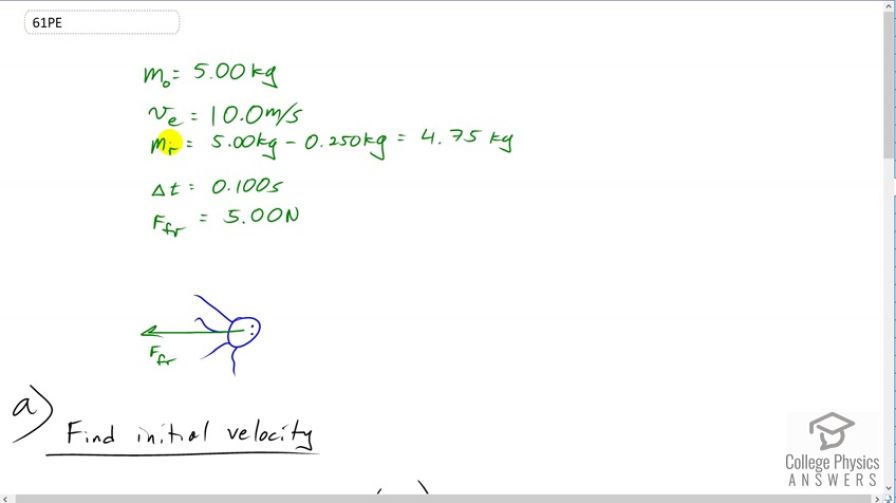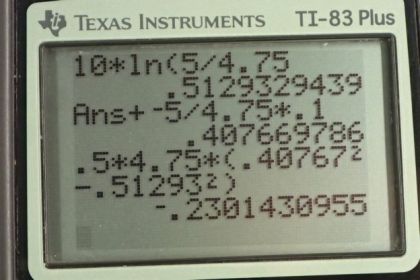Question
(a) A 5.00-kg squid initially at rest ejects 0.250-kg of fluid with a velocity of 10.0 m/s. What is the recoil velocity of the squid if the ejection is done in 0.100 s and there is a 5.00-N frictional force opposing the squid’s movement. (b) How much energy is lost to work done against friction?
Final Answer
a)
b)
Solution video
OpenStax College Physics, Chapter 8, Problem 61 (Problems & Exercises)

vote with a rating of
votes with an average rating of
.
Calculator Screenshots
Video Transcript
This is College Physics Answers with Shaun Dychko. A squid initially having a mass of five kilograms ejects some ink with a speed of ten meters per second. The remaining mass of the squid is then going to be 4.75 kilograms after you take away the quarter of a kilogram of ink ejected. Then the squid will travel for 0.1 seconds through the water and experience a force of friction of five newtons. The question is what will the final speed of the squid be after the 0.1 seconds. So our approach is going to be to find the initial speed of the squid after ejecting the ink and before considering the travel through the water. We'll use this formula from the rockets section to figure out what that speed will be and then given that initial speed we'll consider friction causing such and such acceleration and resulting in a final speed for the squid after 0.1 seconds. So, the initial speed of the squid will be the exhaust velocity so to speak of the ink, which is ten meters per second multiplied by the natural logarithm of the squid's initial mass of five kilograms when it has the ink inside its body, divided by the mass remaining in the squid of 4.75 kilograms after ejecting the ink. This gives a speed of 0.51293 meters per second. We assume that this change of speed happens instantly and that's going to be the initial speed that we feed into this equation, v naught plus a t to find the final speed of the squid. So the net force on the squid when it's traveling through the water is going to be just this friction force, we'll ignore the gravity and the buoyant force which are balanced out and perpendicular to the direction of motion let's say, that's going to be mass times acceleration. I wrote m subscript r here for mass remaining in this case. So we'll solve this for acceleration by dividing both sides by m r and we have acceleration is the friction force divided by the mass of the squid after it has lost its ink. We'll substitute for a in this formula from our kinematics section, final velocity is initial velocity plus acceleration times time, and we'll replace acceleration with force of friction over mass remaining of the squid. So that's going to be 0.51293 meters per second that we figured out before, plus the negative five newtons, and I put negative there because this friction force is to the left say, and it's in the opposite direction to our direction of motion which we'll take positive to the right. That's divided by 4.75 kilograms times 0.1 seconds duration that we're told that the friction force is acting. We get a final speed of 0.41 meters per second. The amount of kinetic energy lost due to the work done by friction is going to be the final kinetic energy of the squid minus its initial kinetic energy before really moving through the water. So that's what we can factor out, the one half m r from both those terms just to make it look a bit cleaner. So it's one half m r times bracket v squared minus v naught squared. So that's one half times 4.75 kilograms times 0.40767 meters per second squared, that's this answer but with more digits because we don't want to have intermediate rounding error, minus 0.51293 meters per second squared. That gives negative 0.23 joules.
